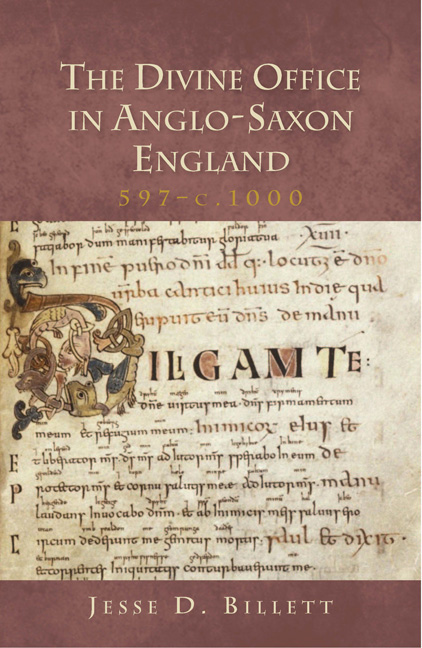Book contents
- Frontmatter
- Dedication
- Contents
- TABLES
- ILLUSTRATIONS
- PREFACE
- NOTE ON USAGE
- ABBREVIATIONS
- MANUSCRIPT SIGLA
- Part I The Historical Development of the Divine Office in England to c.1000
- 1 TOWARDS A ‘NEW NARRATIVE’ OF THE HISTORY OF THE DIVINE OFFICE IN ANGLO-SAXON ENGLAND
- 2 THE DIVINE OFFICE IN THE LATIN WEST IN THE EARLY MIDDLE AGES
- 3 THE DIVINE OFFICE IN ENGLAND FROM THE AUGUSTINIAN MISSION TO THE FIRST VIKING INVASIONS, 597–c.835
- 4 THE DIVINE OFFICE IN ENGLAND FROM THE FIRST VIKING AGE TO THE ABBACY OF DUNSTAN AT GLASTONBURY, c.835–c.940
- 5 THE DIVINE OFFICE AND THE TENTH-CENTURY ENGLISH BENEDICTINE REFORM
- Part II Manuscript Evidence for English Office Chant in the Tenth Century
- Appendices
- BIBLIOGRAPHY
- INDEX OF MANUSCRIPTS
- INDEX OF LITURGICAL FORMS
- INDEX OF BIBLICAL REFERENCES AND LITURGICAL READINGS
- GENERAL INDEX
4 - THE DIVINE OFFICE IN ENGLAND FROM THE FIRST VIKING AGE TO THE ABBACY OF DUNSTAN AT GLASTONBURY, c.835–c.940
from Part I - The Historical Development of the Divine Office in England to c.1000
Published online by Cambridge University Press: 05 November 2014
- Frontmatter
- Dedication
- Contents
- TABLES
- ILLUSTRATIONS
- PREFACE
- NOTE ON USAGE
- ABBREVIATIONS
- MANUSCRIPT SIGLA
- Part I The Historical Development of the Divine Office in England to c.1000
- 1 TOWARDS A ‘NEW NARRATIVE’ OF THE HISTORY OF THE DIVINE OFFICE IN ANGLO-SAXON ENGLAND
- 2 THE DIVINE OFFICE IN THE LATIN WEST IN THE EARLY MIDDLE AGES
- 3 THE DIVINE OFFICE IN ENGLAND FROM THE AUGUSTINIAN MISSION TO THE FIRST VIKING INVASIONS, 597–c.835
- 4 THE DIVINE OFFICE IN ENGLAND FROM THE FIRST VIKING AGE TO THE ABBACY OF DUNSTAN AT GLASTONBURY, c.835–c.940
- 5 THE DIVINE OFFICE AND THE TENTH-CENTURY ENGLISH BENEDICTINE REFORM
- Part II Manuscript Evidence for English Office Chant in the Tenth Century
- Appendices
- BIBLIOGRAPHY
- INDEX OF MANUSCRIPTS
- INDEX OF LITURGICAL FORMS
- INDEX OF BIBLICAL REFERENCES AND LITURGICAL READINGS
- GENERAL INDEX
Summary
The ninth century has been seen as a period of anxiety and decline for the English Church. Threatened by domestic political strife and harassed by pagan invaders, so the traditional narrative goes, monasteries lost all semblance of the true monastic life and the clergy descended into poverty and ignorance. ‘Learning had declined so thoroughly in England,’ lamented King Alfred (871–99), ‘that there were very few men on this side of the Humber who could understand their divine services in English, or even translate a single letter from Latin into English: and I suppose that there were not many beyond the Humber either.’ When the ninth-century decline is considered from a liturgical perspective, however, there is reason to think, despite a lack of conclusive evidence, that the tradition of the Divine Office established in England in the seventh and eighth centuries survived between 835, when the Anglo-Saxon Chronicle first mentions a Viking invasion in the south, and the beginning of Alfred's educational and religious reforms.
The ninth-century decline and its liturgical implications
The poor state of the English Church in the ninth century has been associated with three detrimental conditions: the ever-worsening attacks of Viking raiders, the decline of Latin learning, and the ‘secularization’ of minsters. The Vikings have usually shouldered most of the blame. Clauses in ninth-century charters guaranteeing the validity of transactions only ‘as long as the Christian faith (or baptism) should last in Britain’ show how seriously the Viking threat was taken.
- Type
- Chapter
- Information
- The Divine Office in Anglo-Saxon England, 597-c.1000 , pp. 133 - 148Publisher: Boydell & BrewerPrint publication year: 2014



